


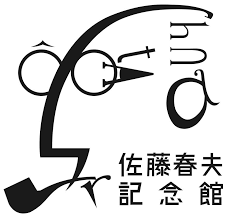
// In 1697, Qing Dynasty official Yonghe Yu’s travels from Fujian to Taiwan in the 1690s, and completed his travel diaries “Travel Via a Small Sea (Sulfur Mining Diary)”. About two hundred years after, Japanese writer Satō Haruo traveled to Taiwan in 1920s and published “The Colonial Journey”. This bio-database cinema follows Yonghe Yu and Satō Haruo’s path, document the soundscape of Taiwan in 2015-2021.“[ Khun-giân ]: The Third Voice” turns the “narrative sound” in the literary scenes to “tones,” “words,” or “short sentences.” As an “OTHER” MOTER TONGUE.
// Director : LIN, Hsin-I
// Programming : LAI, Wei-Han.TSAI, Tai-Zhan
// Performer : YAO, Yu-Wen
// Production Team : Sensory Lab | LIN, Hsin-I.LAI, Wei-Han.TSAI, Tai-Zhan.KE,Tsu-Hao
// Original MIDI Biodata sonification device developed by SašaSpačal, Mirjan Švagelj,and Manuel J. Domke
// Special Thanks
YAO, Yu-Wen.TUNG, Fu-Chi.Haruo Satō.Yuichi Tsujimoto.HaBo MaNis.Katsuuragyokonigiwai Market. Shamisen by JUN Sakima. Sato Haruo Memoria Museum.International Center for Cultural Studies, ICCS.HSU, Shao-En.KE, Tsu-Hao.http://www.qznanyin.cn/.Tainan Shezi Silaya Night Festival.Chingliu Tribe, Nantou.CHEN, Kuan-Chun.CHEN, Jin-Ru.Tatsuya KONO.Academia Sinica Center for Digital Cultures.Center for GIS, RCHSS, Academia Sinica.National Kaohsiung Center for the Arts (Weiwuying).Ministry of Culture




“[ Khun-giân ]: The Third Voice” uses Yong-he Yu’s first travelogue written in 1697 when he came to Taiwan to collect sulfur, “Travel Via a Small Sea (Sulfur Mining Diary), “ and “Travels in the Colony” by Haruo Sato, as a dual path through the literary axis of the voice narrative. Starting with the island of She-liao, finding voices from the incidents in Wushe, Hsinchu and the air raids in Tainan, and intertwining with the voices of Dr. Xin-Rong Wu’s diary, indigenous people’s chants, local oral traditions, artists’ counter-phonetics, and Taiwanese Zhuzhi-ci ( 竹枝詞 ), they interweave a subjective hearing-point and a transitive soundscape where voice, language, and sound are mutually diluted.
“[ Khun-giân ]: The Third Voice” consists of “sound groups” and “sound sites.” Sound groups include three sound programmed objects: IOT temperature and humidity sensing, ambient vibration sensing, and bioelectrical impedance data sensing. The three sound groups respectively trigger three sets of sounds. Triggered by the ambient temperature and humidity sensing, it shows the chanting of indigenous people, the counter-phonetics of the artists (Fu-chi Tung recites the 1944 and 1945 Tainan air raids and the Wushe incident written by Dr. Xin-Rong, Wu in reverse order of the Mandarin Phonetic Symbols), the Quanzhou Nanyin (泉州南音), and the Taiwanese Zhuzhi-ci (竹枝詞). By ambient vibration sensing, it shows the chanting of Okinawa’s shamisen and the sound of Japanese drums. And by bioelectrical impedance sensing, the biodata triggers the sound of Haruo Sato reciting his poem “ The Song of Saury “ and the sound of Yuichi Tsujimoto, the director of the Haruo Sato Memorial Museum, reciting the poem.
The three sets of sounds were captured from the shots and sounds collection in Japan, Okinawa, and Taiwan between 2015 and 2021, disassembling the sounds into “tones,”“words” or “short sentences.” The “sound group” devices will trigger different “tones”, “words” and sounds, depending on the geographical location and environment of the site. Similarly, depending on different electrical impedance values of different organisms (sweet potatoes, plants, or humans), different “words” or ” short sentences ” will be triggered. In particular, the temperature and humidity sensing will be able to let certain sounds recede due to changes in temperature (number of people or low temperatures in highland), and some sounds will only be triggered when the temperature is below certain degrees.
The Non-Diegetic Sound that comprises the sets of sound in “ sound groups” and their programming language, defines the image editing of the “Sound Scene.” The video will consist of image interlacing between “sound groups” and “images groups,” with the sensors objects triggered by “sound and images groups” projected on the wall in real-time, including the entire interaction and live shooting and recording. In the post-edition, the live shooting and recording will interlace as a Montage with the origin video of “Sound Scene.”
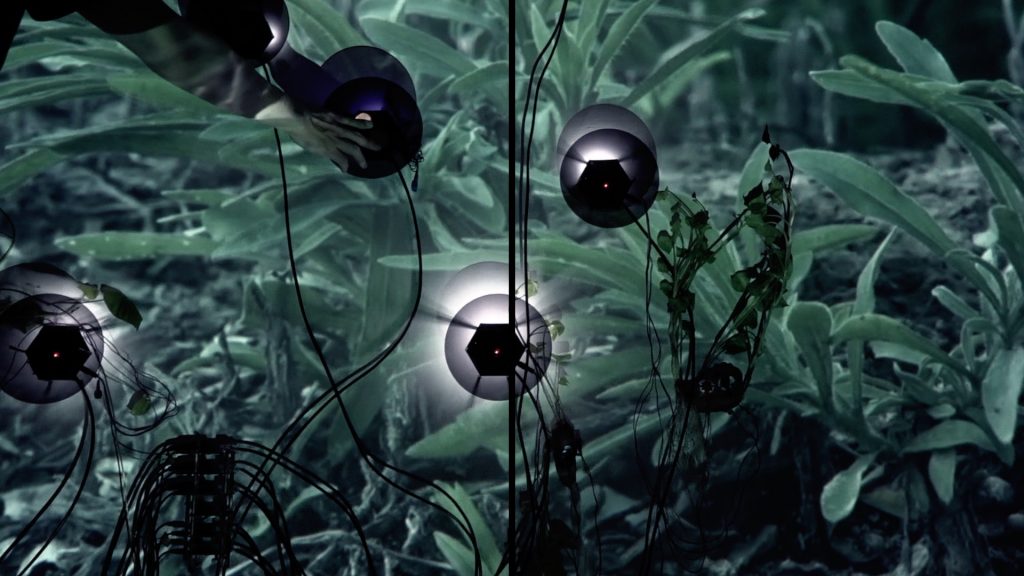
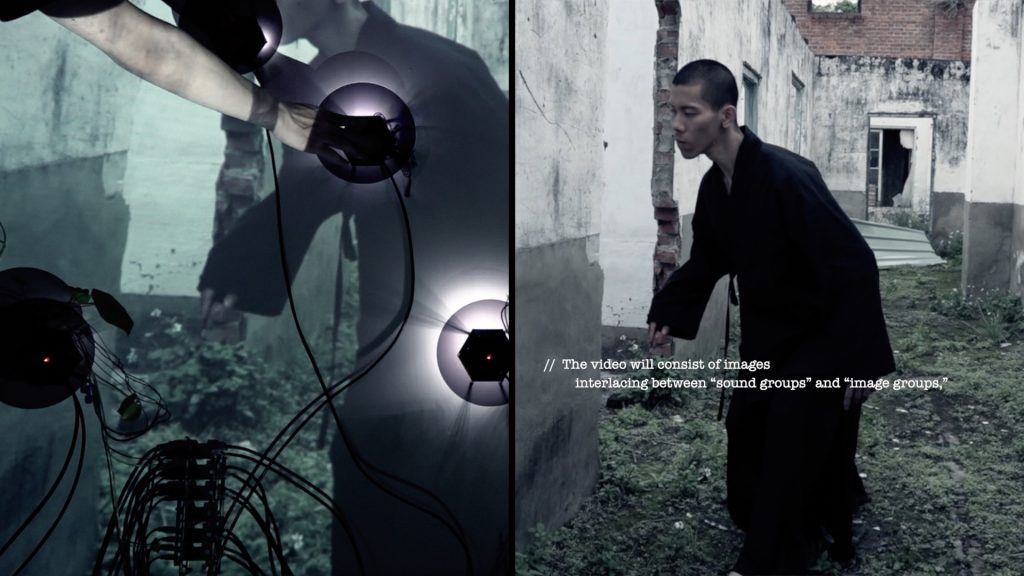

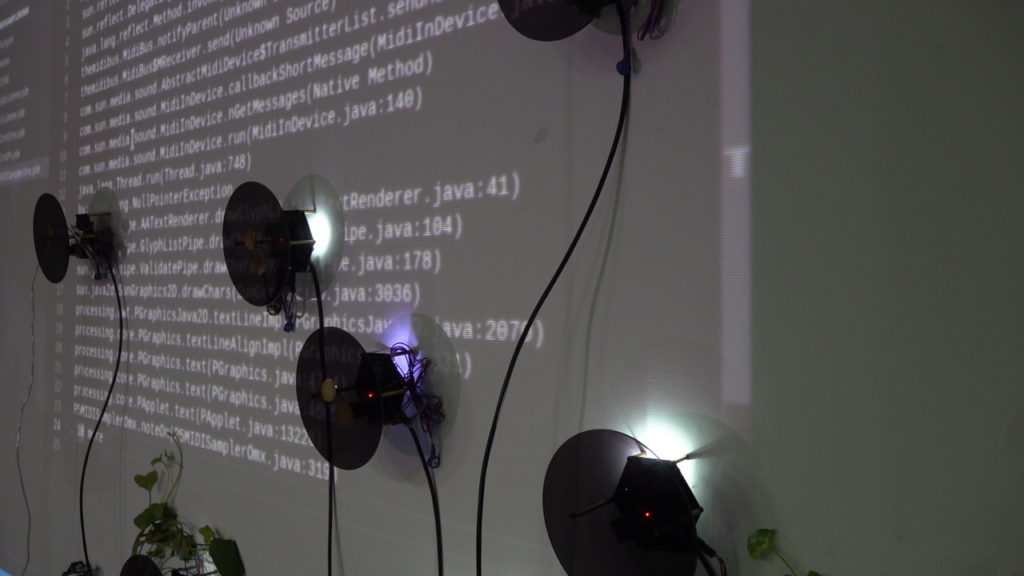
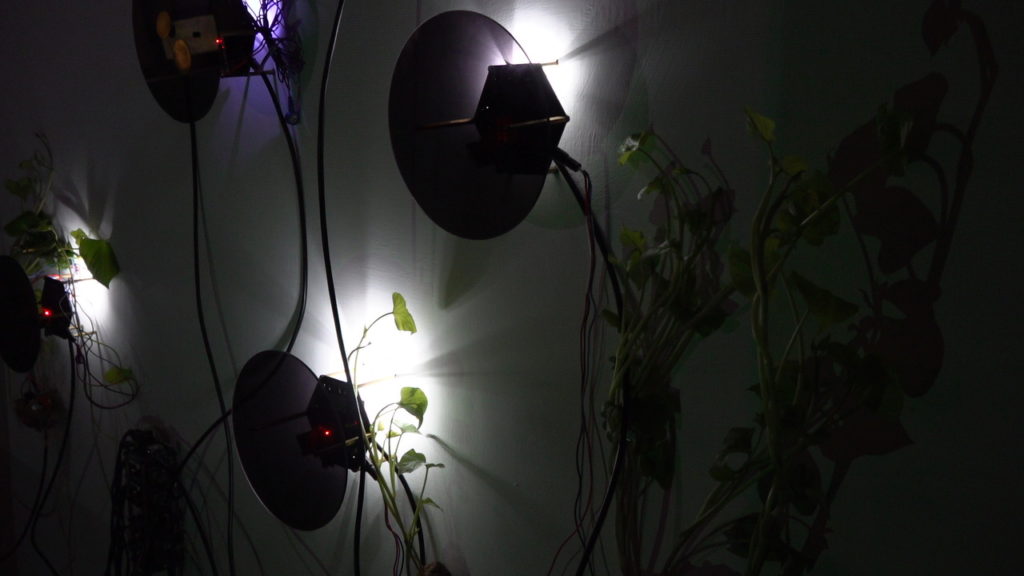
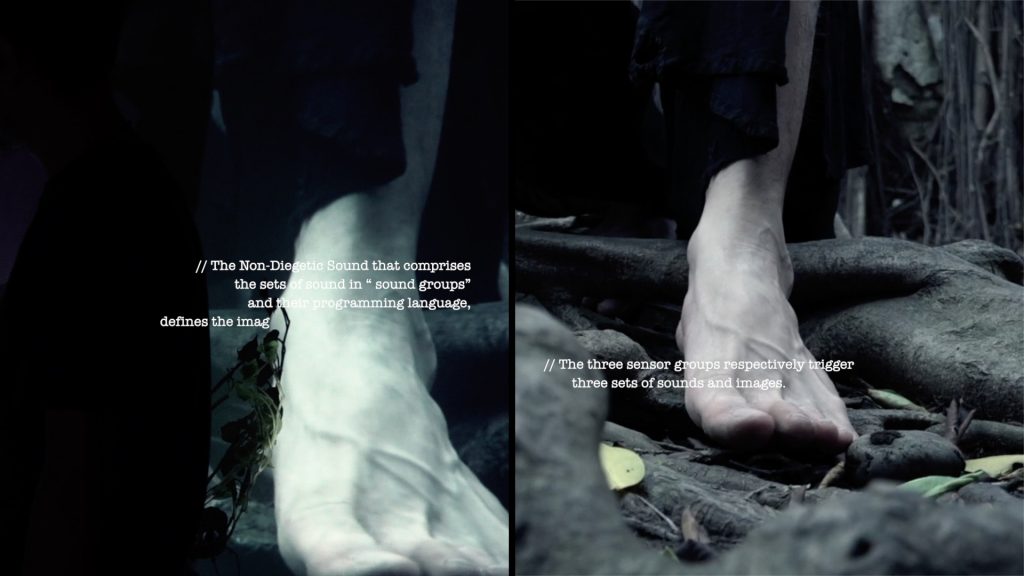
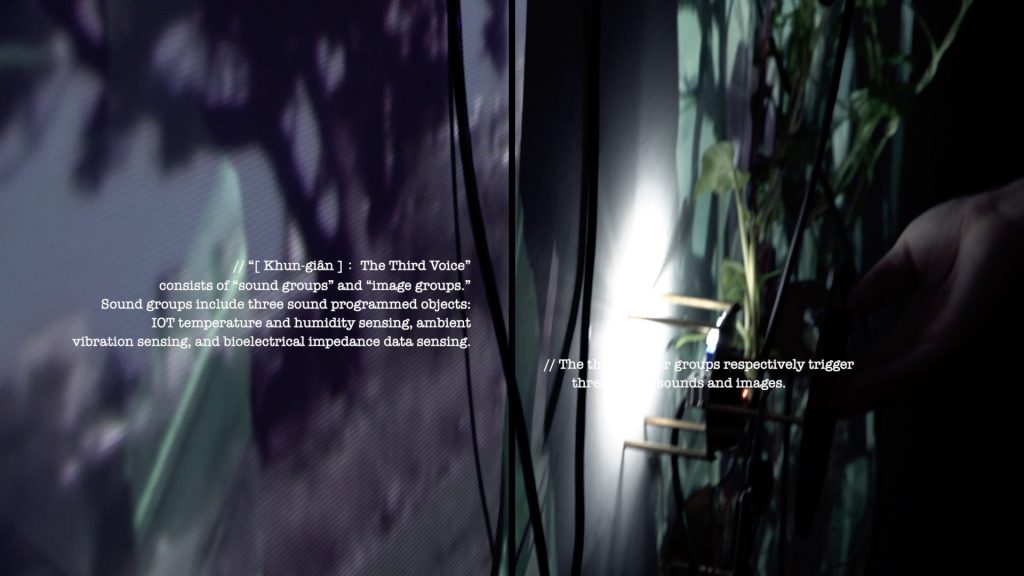
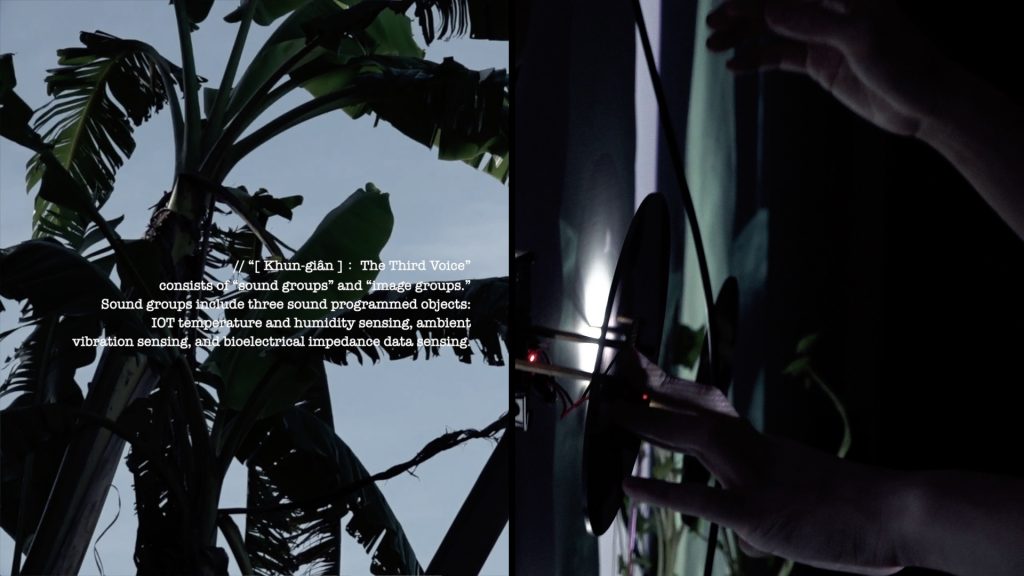
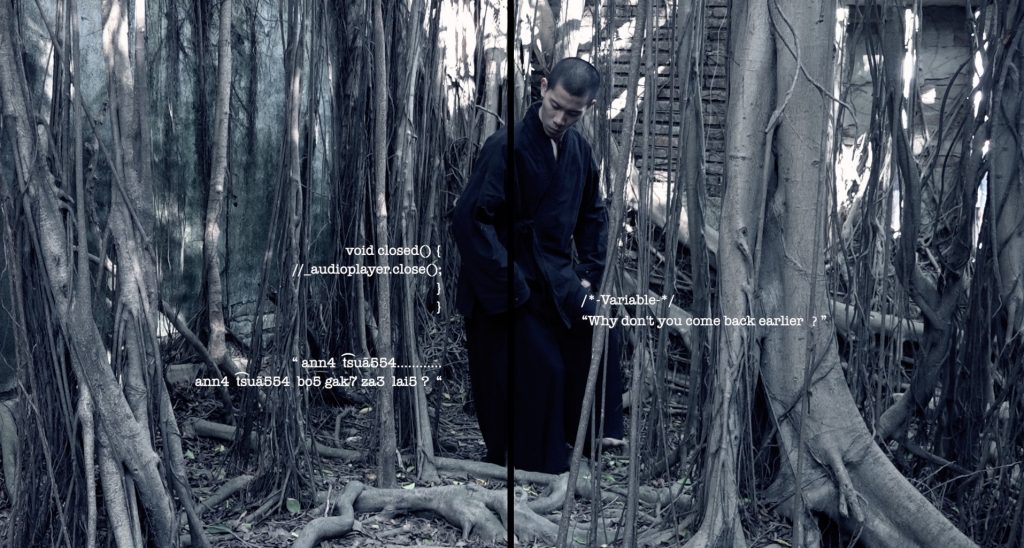
The first node on the sound path of “[ Khun-giân ]” was filmed in 2015: the “Dutch Cave”(蕃字洞) on the island of She-liao in Keelung is the first place where the Spanish language appears in Taiwan. The first record of Dutch inscriptions in the stone caves of She-liao Island is in the book “Ile Formosa” by French M. C. Imbault-Huart (published in 1898, p.195). The scene index starts from the sound path of “Travels in the Colony” by Haruo Sato, seeking the literary inscription. Visiting from the island of Shel-iao in Keelung to the Anping port in Tainan (the ” The Lessons-for-women Fan ” and the Tainan air raid incidents), to the Gluban tribe of Kawanakajima in Wushe, Nantou, and to the Haruo Sato Memorial Museum in Shingu, Japan. These paths parallel the places where Yong-he Yu came to Taiwan, forming a triple space-time (1697-1920-2021) documentary image. Although Haruo Sato’s route to Taiwan concentrates on the ‘left-side of the island’ (Tu-Niu Boundary, ‘土牛界線,’ the boundary of the West Plains Indigenous and the East Alpine Indigenous, later known as the defense lines of frontier guards, ‘隘勇線’), which is similar with the route taken by Yong-he Yu to collect sulfur in Taiwan, the former cuts through the middle and eastern parts of Taiwan as far as Nenggao Cross-ridge (能高越嶺), while the latter does not cross to the east and travels more dispersedly and widely than the former. Even though there is a chronological gap between the depiction of the indigenous Wushe people of Taiwan in Haruo Sato’s work and the depiction of the Plains Indigenous people in Yong-he Yu’s “Barbarian Zhuzhi-ci ” (〈土番竹枝詞〉) in “Travel Via a Small Sea (Sulfur Mining Diary), ” they both show the judgment of hetero-ethnicity and a ” non-coeval time-lag/parallax” about the foreign language and the local sound and music. It is because the filming path is overlapping with literary texts (or historical events) that the experience of filming and interviewing for “[ Khun-giân ]” constantly questions where the “third voice” is heard. “[ Khun-giân ]” does not seek to represent historical scenes, or to call upon the body of the event as a “third subject” in the oral voices of those who experienced it, or to provide historical narration. In fact, the “third voice” does not exist in a specific, single body/subject; instead, it is always beyond the scene, the documentary image, and the screen, waiting to be triggered and presented through hearing.
In the abandoned house in Thut-thau Port, Tainan, the only foreign language that appears in the text, “Quanzhou dialect”, triggers Haruo Sato to trace the “sound of the deceased spirit “: “Why …… why don’t you come earlier?” (ann4 t͡suã554….. ann4 t͡suã554 bo5 gak7 za3 lai5 ?) In the XI Taiwanese Zhuzhi-ci (竹枝詞) by Yong-he Yu, there is also a description of the traditional opera in Quanzhou and Zhangzhou. The word “Chu-li” (侏離), which originally meant the strange and incomprehensible voices of minorities or foreigners and barbarians from the West, is used in the Zhuzhi-ci (竹枝詞) to describe the Hokkien tone of the Quanzhou and Zhangzhou area sung by the local actors. In ” The Lessons-for-women Fan, ” in addition to the “sound of the deceased spirit/ Quanzhou dialect, ” there is also a Taiwanese voice at the end of the text, “lí lâi-ah, tshiánn-tsē” (“Here you are, please take a seat.”), spoken by a white parrot kept by the grain merchant, Huang. The appearance of this personified voice is not merely a scene description, but one of the punchlines in the text. In ” Travels in the Colony, ” besides the characters’ “dialogue,” special descriptions of voices include the Chinese dialect of the Xiamen area in “Journey to the Sun Moon Lake,” a description of the tone of a wooden pestle striking a stone “as clear as a metal tone,” a popular song started from the Japanese 50 syllabaryいろはin the Taisho period (presumably the “Iroha Song”) [Note 4], a pilgrim’s hymn, the bird chirps of La Li Lu Le Lo in “The Locust’s Great Journey,” the Ma Ha Fu Ne verbalize nouns in “The Devilbird,” or the music of bowed-stringed instrument in ” The Lessons-for-women Fan, ” and the chanting of the Ryukyu shamisen in “The Travel to She-liao Island.” It is these “words and voices” that create the colonial auditory space in Sato’s ears, while Yong-he Yu’s Taiwan is filled with sensory or visual descriptions of the ecological and living features of the indigenous daily objects, of plants (banana, plumeria, betel nut, thorny bamboo, fan-suainn (番檨, mango), xiao-lang(蕭朗), Mesua ferrea, etc., see volume I), and of animals (giant snakes, stags, Malayan sun bear, wild swine, etc., see the “Supplement to the barbarous land,”“番境補遺”). The body movement during filming interlaced with the two different sensory writings. “[ Khun-giân ]” begins to focus not on the oral presentation of the characters in the front, but on the entangled sound and physical scene beyond the events and the characters.
“[ Khun-giân]” turns the “narrative sound” in the literary scenes to “tones,” “words,” or “short sentences.” The narrative intention behind the text and the photographer is unreadable; however, a new “third voice” is gradually formed as the voice and the scene are inter-dismantled and inter-diluted. When these “tones,” “words” or short sentences” are neither in the narrator’s body nor in the filmmaker’s edition of the scene, but through a group of “entangled sound objects,” connection between scenes, and “transitive verbs” that are triggered by the physical impedance of different environments and subjects. Perhaps, the sound path of “[ Khun-giân]” begins to emerge as its own “sound site.” The French acoustic theorist Michel Chion refers to an interview in which John Cage repeats “I don’t need a voice to speak to me.” This statement implies that we cannot really “hear,” but rather align “narrative” and “narrator” in voice, hearing a Voice within the Sounds, and projecting words, clarity and intention onto the “speaker” and the “authority of speech.” This mode of perception allows the sense of hearing to be dependent on, and glued to, the visual image; however, for Chion, we should “only need the voice to speak to us,” without the narrative and spatial positioning induced by the “speaker.” In Chion’s 1994 book on film sound, “Audio-vision: Sound on Screen,” he states that “‘the POA (point of audition)’ should be understood as a space or area’ (Chion 1994: 90). The “point of subjective audition” refers, on one hand, to the situation in which the audience shares in the subjective auditory experience of the character in order to enter the character’s inner world; on the other, in a spatial sense, as the spatial location in which the audience “hears” the visual narrative presented in the image, which gradually constitutes a displacement of the viewer’s subjective perspective on the content of the image. The sound logic of “[ Khun-giân]” attempts to constitute the auditory space of the scene from the entangled sound objects off-screen and the “subjective hearing-points” of the viewer, diluting the auditory adhesion to the possible narrative of the images with the projected documentary video clips, and allowing only the sound to speak for itself and the viewer’s own subjective hearing-points to return to their own space through sound. And we can then find the third voice in this sound path.
.Mladen Dolar 2006. A Voice and Nothing More. Cambridge: MIT Press.
.Michel Chion 2016. Sound an acoulogical treatise. Duke University Press.
.Michel Chion 1994. Audio—vision: Sound on Screen. Columbia University Press; 14th edition
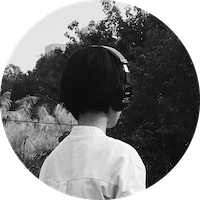
FILMOGRAPHY
LIN, Hsin-I is an independent filmmaker. She is the director of the award-winning films Letter #69 (2016), 3 Islands (2015).
Along with her intention to develop new issues, she has turned toward reflexive ethnography documentaries and third voice films. She has screened films at multiple film festivals and museums including the Singapore International Film Festival, Busan International Short Film Festival, Hong Kong Independent Film Festival, Media Library, Visions du Réel International Film Festival NYON, Urban Nomad Film Fest, Women Make Waves Film Festival, Kaohsiung Film Festival, South Taiwan Film Festival, and various international film festivals and museum.
// 2022 VIDEOFORMES 2022 – Festival International d’Arts Numériques de Clermont-Ferrand
// 2021《Film Screenings》About 228 Incident, the Martial Law, and the Democratization in Taiwan, Taiwanverein in Deutschland e.V
// 2021 Taoyuan Arts Cinema II : Blooming silence
// 2020 Taiwan International Human Rights Film Festival
// 2019 Oppression and Rebirth – 2019 AMA Museum Women’s Human Rights Film Festival
// 2018 29th SGIFF:FOCUS: DOCU-MEMORIES SHORTS
// 2018 Kosovo DokuFest: “Birth of a Nation: Focus on Taiwan”
// 2018 Wathann Film Festiva
// 2017 What Time Is It There?: Taiwanese Film Biennial, UCLA Film & Television Archive and the Taiwan Academy in Los Angeles
// 2017 Media Library, Visions du Réel International Film Festival NYON Media Library
// 2017 Landscape of Asian Shorts section, Busan International Short Film Festival, South Korea
// 2017 Hong Kong Independent Film Festival
// 2016 Outstanding Selection, Kaohsiung Film Festival
// 2016 Merit Prize, Women Make Waves Int’l Film Festival
// 2016 Urban Nomad Film Fest2016 NYC Independent Film Festival
// 2016 New Youk Independent Film Festival
// 2015 Rookie of the Year Award, South Taiwan Film Festival
// 2015 Women Make Waves Film Festival – Taiwan Competition
// 2015 Los Angeles Independent Film Festival Awards
// 2015 Canada Shorts Film Festival
// 2015 Asia Art Center of Gwangju. Self-Archiving
// 一但語言的存在被排除,所剩的只有語言在表象中的功能 // 表音
// 及物變因:與系統的硬體或軟體相對的觸覺、手勢、溫度、震動、濕度、植物
// catch (IOException e) {
println(“Err GetCmdStream”);
temperature = 25;
return temperature;
}
“ 泉州南音.鼓.反聲語.臺灣竹枝詞.原吟 ”
void SetVolume(float vol) {
//_audioplayer.setGain(vol); //max:0dB min:-80dB
//_audioplayer.amplitude;
{ 聲音異步連結成為語法 }